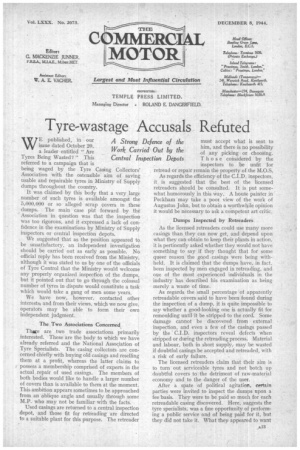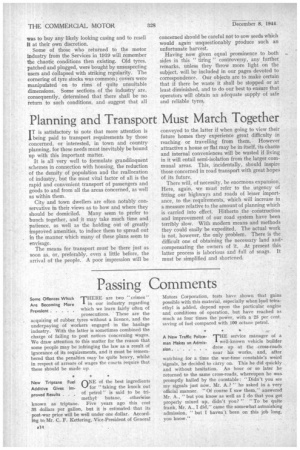Tyre-wastage Accusals Refuted
Page 15

Page 16

If you've noticed an error in this article please click here to report it so we can fix it.
WE published, in our issue dated October 20, a leader entitled "Are Tyres Being Wasted?" This referred to a campaign that is being waged by the Tyre Casing Collectors' Association with the ostensible aim of saving usable and repairable tyres in Ministry of Supply dumps throughout the country.
It was claimed by this body that a very large number of such tyres is available amongst the 5,000,000 or so alleged scrap covers in these dumps. The main case put forward by the Association in question was that the inspection was too rigorous, and it expressed a lack of confidence in the examinations by Ministry of Supply inspectors or central inspection depots.
We suggested that as the position appeared to be unsatisfactory, art independent investigation should be carried out as early as possible. No official reply has been received from the Ministry, although it was stated to us by one of the officials of Tyre Control that the Ministry would welcome any properly organized inspection of the dumps, but it pointed out that to go through the colossal number of tyres in dispute would constitute a task which would take a gang of men some years. We have now, however, contacted other interestso and from their views, which we now give, operators may be able to form their own independent judgment.
The Two Associations Concerned Thee are two trade associations primarily interested. These are the body to which we have already referred and the National Association of Tyre Specialists. The casing collectors are concerned chiefly with buying old casings and reselling them at a profit, whereas the latter claims to, possess a membership comprised of experts in the actual repair of used casings. The members of both bodies would like to handle a larger number of covers than is available to them at the moment. This ambition appears sometimes to be approached from an oblique angle and usually through some M.P. who may not be familiar with the facts.
Used casings are returned to a central inspection depot, and those fit for retreading are directed to a suitable plant for this purpose. The retreader must accept what is sent to him, and there is no possibility of any picking or choosing. Those considered by the inspectors to be unfit for retread or repair remain the property of the M.O.S. As regards the efficiency of the C.I.D. inspectors, it is suggested that the best of the licensed retreaders should be consulted. It is put somewhat humorously in this way. A house painter in Peckham may take a poor view of the work of Augustus John, but to obtain a worthwhile opinion it would be necessary to ask a competent art critic.
Dumps Inspected by Retreaders As the licensed retreaders could use many more casings than they can now get, and depend upon what they can obtain to keep their plants in action, it is pertinently asked whether they would not have something to say if they thought that for some queer reason the good casings were being withheld. It is claimed that the dumps have, in fact, been inspected by men engaged in retreading, and one of the most experienced individuals in the industry has described his examination as being merely a waste of time. As regards the small percentage 'of apparently retreadable covers said to have been found during the inspection of a dump, it is quite impossible to say whether a good-looking one is actually fit for remoulding until it be stripped to the cord. Some damage cannot be discovered from external inspection, and even a fewof the casings passed by the • C.I .D. inspectors reveal defects when stripped or during the retreading process. Material and labour, both in short supply,. may be wasted if doubtful casings be accepted and retreaded, with a risk of early failure. • The licensed retreaders claim that their aim is to turn out serviceable tyres and not botch up doubtful covers to the detriment of raw-material economy and to the danger of the user. After a spate of political agitation, certain parties were invited to inspect the dumps upon a fee 'basis. They were to be paid so much for each retreadable casing discovered. Here, suggests the tyre specialists, was a fine opportunity of performing a public service and of being paid for it, but they did not take it. What they appeared to want was to buy any likely looking casing and to resell It at their own discretion.
Some of those who returned to the motor Industry from the Services in 1919 will remember the chaotic conditions then existing. Old tyres, patched and plugged, were bought by unsuspecting users and collapsed with striking regularity. The cornering of tyre stocks was common ; covers were manipulated on to rims of quite unsuitable dimensions. Some sections of the industry are, consequently, determined that there shall be no return to such conditions, and suggest that all concerned should be careful not to sow seeds which would again unquestionably produce such an unfortunate harvest.
Having now given equal prominence to both sides in this " tiring " controversy, any further remarks, unless they throw more light on the subject, will be included in our pages devoted to correspondence. Our objects are to make certain that if there be waste it shall be stopped or at least diminished, and to do our best to ensure that operators will obtain an adequate supply of safe and reliable tyres.




















































